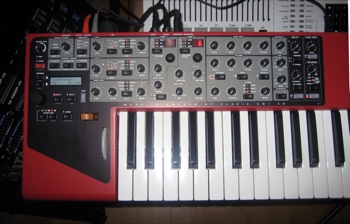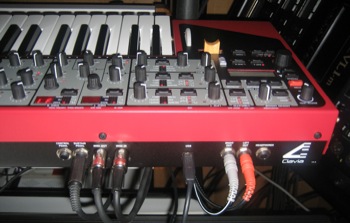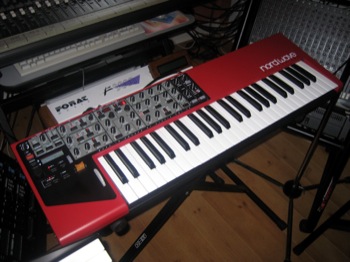Integrating analog modeling, FM synthesis, digital waveforms, and sample playback, the Nord Wave positions itself as a versatile multi-synthesis specialist. Focusing on immediate programming as opposed to navigating through endless menu pages, does it have what it takes to stand out from the rest?
In 1995, Clavia introduced the Nord Lead, a small red bomb modeling polyphonic analog synths of yesteryear. The machine also came with a sound bank from the original Prophet-5. In the following 10 years, it gave birth to gifted offspring, exploring FM synthesis on the way, with the Nord Lead 3 and its fancy luminous interface. The Swedish manufacturer was quick to explore the world of virtual modular synths, with a family just as gifted that allowed it to model many signal processing tools. The only thing missing was sample reading, something which Clavia was soon to develop in order to generate some of the sounds of its keyboards destined for playing live. The Nord Wave therefore has profited form the know-how of the brand. Now at maturity, with a stable OS (1.08) and coming with an additional bank of 250 MB of Mellotron samples, a test was called for …
Getting Started
 |
True to Clavia tradition, the Nord Wave synth is both lightweight and solidly built. Weighing in at 6 kg on the scale in a red and black frame all in metal the machine was made for live gigs. Controls (33 knobs, 3 notched endless encoders, 33 buttons) are firmly attached to the front panel (they won’t be going anywhere!). As usual, they’re all grouped together on the left half of the machine. You either like it or you don’t. In any event, the controls are too crowded and too small for tired eyes and trembling hands. In addition, the screen is on the extreme left, which isn’t practical for reading. All parameters except for global/Midi settings are accessible directly from the front panel. Some buttons have an alternate function which is accessible by pressing “Shift”. The sections are pretty clear, with (from left to right): modulations (portamento, LFO, assignable envelope), 2 oscillators, a filter with its envelope, the volume with its envelope and its effects. Work flow and ease of use are strong points of this machine. The LCD screen (2 × 16 characters) completes the picture: in addition to the names of programs, the LCD screen shows the value of all parameters while editing, especially the names of multi-samples and digital waveforms. Note that the value of certain parameters is shown in its true unit of measurement: frequency in Hz, time in seconds, intervals in semitones … nice! A dedicated “Panic” button can cut all notes and is ideal for gigs. Some small shortcomings: there’s no “compare” button and rotary knobs only function in “jump” mode.
 |
As for its keyboard action, the Nord Wave offers a lightweight 4-octave keyboard (49 keys) that’s sensitive to both velocity and pressure. Its feel and dynamic response are comfortable and responsive to nuances, however, the pressure control is very abrupt and not very expressive. It’s a shame that Clavia hasn’t switched to the standard 5 octaves, especially to play multi-samples. To overcome the lack of octaves, there are buttons that quickly transpose, plus or minus 2 octaves, near the cool pitch stick without a central position and the modulation wheel. On closer examination, the back panel proves to be a disappointment (picture on the left): one pair of audio outputs, a headphone jack, a duo Midi, 2 Pedal outputs, and a USB socket (see box on sample management). So goodbye multiple outputs, digital audio, MIDI Through … There’s only internal power to console us, which is surprising from a machine of this level and price.
A Wide Range of Sounds
|
With several synthesis engines, the Nord Wave has an extensive sound range: imitations of vintage analogs, digital/FM hybrids, but also acoustic instruments with a 180 MB FlashRam pre-filled to 90%. The multi-samples are well assembled, rather well looped, musical, but suffer from a big oversight in the machine’s design: the impossibility of working on multiple dynamic layers. The result is a lack of expressiveness in some acoustic sounds, the dynamics of attacks are limited merely to controlling the level and opening of the filter, like with basic and old sample players. This is particularly obvious on piano, strings (large sections or small sections), bass, guitar, brass or trombones. The other sampled instruments sound better : electric bass, church organ, choirs. The best part of this multi-sample bank is undoubtedly the Mellotron, since its samples are static. The Nord Wave offers no less than 250 MB recorded from a brand new Mellotron built from original parts. Clavia has acquired the rights to the original Mellotron MKI, MKII, M300 and M400 tapes. In the end, no fewer than 65 multi-sample are delivered on CD with the machine, some of which are already included on the FlashRam. Here are some examples, with no additional effects: 3Violins, 16Violins, AltoSax, BoysChoir and Brass.
 |
As for synth sounds, Nord Wave comes into its own here. It shines in all areas: synth basses, soft leads, with portamento, synchro, arpeggios, FM/digital sounds or pads. It’s a virtual compilation of much of the history of synthesis. One indispensable test on digital synths is testing the extreme highs and lows . In the highs, the Nord Wave performs very nicely: no aliasing effect or other digital noises, whatever the form of synthesis used. In the bass, just as convincing and you must go very low to really get unpleasant metallic effects. A very nice overall performance!
Multiple Synthesis
The Nord Wave is a digital synthesizer with 18-note polyphony. The memory contains 8 banks of 128 programs, including 3 pre-programmed in the factory. Fortunately, you can scroll through programs by number, category or alphabetically. Simple and effective! Each program has 2 slots (A and B) that can be stacked or played on 2 separate MIDI channels. But you can’t separate the 2 slots, nor trigger either one through velocity, nor edit them both at the same time! These are shortcomings that the current OS (1.08) has not yet addressed. Each slot is an independent synthesizer with 2 oscillators, 2 filters, 2 LFOs, 3 envelopes, 1 EQ and 1 chorus. The first oscillator is capable of producing virtual analog waves (pulse, triangle, sawtooth, sine, with internal sync), cyclical digital waves (62 waves like organs, bells, spectral), FM synthesis and variable noise (there’s a dedicated adjustable 12 dB/octave filter). The second oscillator, which is more powerful, can produce virtual analog waves, assemblies of sampled transients, digital waveforms on a cycle (22 types), FM synthesis, and read multi samples (see box below).
For each oscillator, the FM synthesis works with 2 sine wave operators (a modulator and a carrier). You can therefore achieve FM synthesis with 4 operators, like with a Yamaha DX. Rather than offering a lot of complex algorithms with access to all frequencies, Clavia has opted for a few global algorithms whose frequency ratios are set. There are 9 algorithms whose modulation ratios range from 1 to 9 without feedback and the same ones with feedback. If both FM oscillators are used, they can inter-modulate, which increases possibilities. With a DX, you just need 2 algorithms to do this, the Nord Wave offers a very watered down but immediate version of FM synthesis. A “Shape” parameter is used to vary harmonic content of waves, depending on their type. On a virtual analog wave such as a square, it changes the pulse’s width, if sync is initiated, it will play on the slave oscillator’s frequency; with an FM wave you can vary the modulation level and/or feedback according to the algorithm. Better still, the oscillators can interact regardless of their type, which is a strong point of this machine. Thus, a multi-sample will, for example, be able to modulate a wave cycle, or frequency, or phase. In the first case, it expands the spectrum of the wave, resulting in both a more raw and brighter sound. In the second case, it shifts the whole harmonic content, producing more fluid changes than FM.
|
Complex Filters
The filter is a multi-mode resonant type. It offers 6 modes: low pass, high pass, bandpass, comb, multi, and vocal. The low pass filter is very musical and colorful with well rounded low-frequency resonance and not sibilant at all, as you can hear in this mini arpeggiated sequence. In contrast, you can hear the significant instability of the sound, with a sudden increase of volume just before the self-oscillation then a global collapse of volume. It’s difficult to really control it all … The cutoff frequency range from 14 Hz to 21 kHz is a bit wider than the audible range. The bandpass filter creates ethereal sounds and is ideal for pads (filter only, filter with self oscillation) or in conjunction with a low pass filter (stacking 2 slots).
The comb filter achieves Phaser-like effects. The multiband filter works on 3 peaks whose relative distance is fixed. The “Freq” parameter is used to adjust the center frequency. The voice filter is actually a very unstable resonating double bandpass filter. Resonance is used to adjust the width between the 2 peaks. This filter allows the creation of formants, vowels, and internal resonances, like in this example. Beyond these modes, the filters can work at 12 and 24 dB/octave (i.e. 2 and 4 poles). The difference to the ear is not all that obvious on moderate filtering, as heard here. By pushing these filters you can begin to differentiate between the 2 modes, like in this pad. Lastly, keyboard tracking has 3 positions (1/2–2/3–3/3) and velocity can modulate the filter envelope, like in this vocal mini-sequence.
Simple Modulations
|
Both LFOs oscillate from 0.03 to 523 Hz, an interesting range that can reach audio levels. The 5 basic waveforms are present: square, sawtooth (inverted LFO2), triangle, random discrete and continuous random. Depending on the LFO, the destinations of modulations are the pitch of each oscillator, the amount of intermodulation, the “Shape” parameter, the cutoff filter, resonance and panning. The cycle can be independent for each voice or synchronized between all voices, but it’s impossible to synchronize the LFO to any clock or even modulate the volume with an LFO, which is a disappointment. In “Single” mode, the LFO only spans one cycle. However, there’s no delay. There’s also a global vibrato, which allows you to adjust the pitch with a fixed delay (3 settings), the wheel, or aftertouch. That’s all the Aftertouch is able to modulate, booooo!
As for envelopes, there are 2 ADSR and 1 switchable AD/AR . Attack time ranges from 0.5 millisecond to 45 seconds, while decay and release time ranges from 3 milliseconds to 45 seconds. Both ADSR are assigned to the filter and volume, impossible to use them for other modulations, pffft! In contrast, the AD/AR can be assigned to the oscillators’ pitch, their intermodulation, the “Shape” of oscillator 2, and the cutoff filter. Apart from the 2 oscillators, it’s impossible to assign it to multiple destinations simultaneously. The modulation amount of this envelope is bipolar. In monophonic mode, you can choose (or not) the re-activation of envelopes. I like the speed of these envelopes, with a characteristic click that can be heard on this bass sound.
Long Live Morphing!
 |
One can conclude that the possibilities of modulation with this keyboard are rather static. While the essential is there, it’s a far cry from the modulation matrices developed by some of Clavia’s competitors. All this would be very disappointing if there wasn’t a great Morphing section (for which the brand is well known). The idea is to program 2 different values for 26 morph destinations and get a gradual transition from one to another using a physical controller: velocity and position of the keyboard or the modulation wheel in conjunction with expression pedal.
To assign a parameter, you just need to keep a key pressed and make adjustments. The screen indicates the parameter’s original value and the morphed value. Among the assignable parameters there are the LFOs (rate and amount), envelopes, oscillator “Shape” parameters, their intermodulation, mixing them, unison, filters (freq and resonance), output level and delay amount . It’s a shame we can’t allocate more effects parameters … Nevertheless, this section is one of the strong points of the machine because it makes the Nord Wave really expressive. To view assigned parameters, the selected morph destination’s green LED will indicate that a morph is active. Not as spectacular as the light show of the encoders on the Nord Lead 3, but useful nonetheless. Finally, note that the Nord Wave has a portamento function with a simple timing setting and a chord memory function (3 notes) stored within each program.
A few effects
 |
Like most vintage analog synths, the first modeling synths didn’t have effects sections either, except for maybe a small chorus or delay. The Nord Wave fortunately shakes off this bad habit by going a little further. Beginning with an independent EQ and Chorus section for each slot. The EQ is a 2-band with a shelving characteristic, with adjustable gain (from –15dB to +15dB) applied to frequencies under 100 Hz and above 4 kHz. The Chorus has 3 positions, corresponding to different intensities, and is reminiscent of the Elka Synthex. Basic and simplistic at first glance, it’s a real success in terms of sound which lets you add depth and roundness. Just as with the Synthex, if you cut the chorus on some programs everything becomes bland …
All other effects are common to both slots in a program, which is a shame. The delay has a time interval of 64 ms to 2.26 seconds. The feedback parameter sets the number of repeats in a very limited way. A switch activates the ping-pong stereo mode. The amount knob controls the amount of the delay effect in the audio signal. Even though there’s a tap tempo button, it’s impossible to synchronize the delay with a global clock, which is once again very disappointing. After that there’s a tube type overdrive with a drive parameter. It’s useful in low settings on polyphonic type programs like electric piano; in mono, pushing the overdrive gives you a guitaristic sound. All this makes us regret, once again, that the effect is global to both slots! Lastly, a small reverb completes the processing chain. It’s rather simplistic, with only 5 settings (rooms and halls) and a dry/wet knob. It’s a little too basic in terms of algorithms and settings: a plate and/or spring reverb simulation would have made my day, as well as an HF filter and timing settings. But basically this reverb section sounds pretty good!
Conclusion
In the end, the Nord Wave is a concentration of synthesis types with excellent musicality. User friendly, robust, and lightweight, it’s made for live situations, like all Clavia products. Its range of sounds is surprising, with very different and perfectly complementary timbres within easy reach. If you add to that the intermodulation of oscillators, the excellent library of Mellotron samples, you should be satisfied… except, that for this level, some aspects just barely cut it, especially the keyboard, multi-timbrality, connections, computer dependence for sample management, and certain sections that aren’t sufficiently developed. In any event, for those who put sound quality at the top of their priority list, as well as the variety of sounds and ease of use, it’s hard to beat the Nord Wave at the moment.
